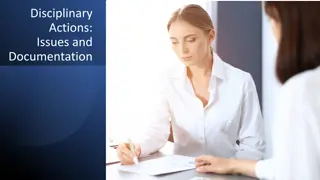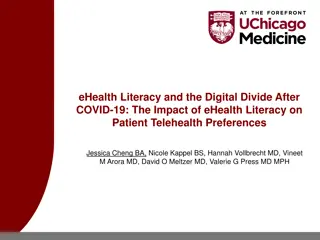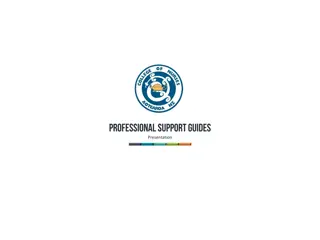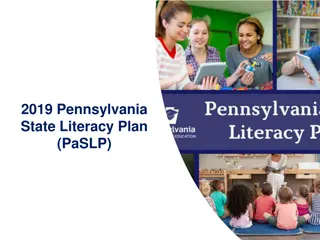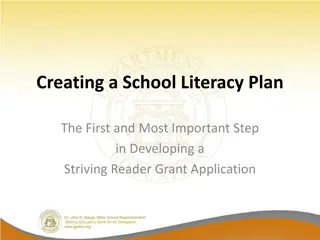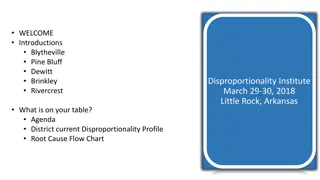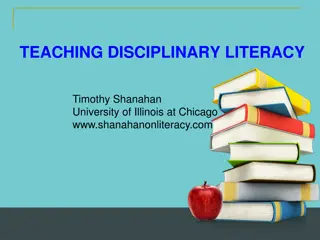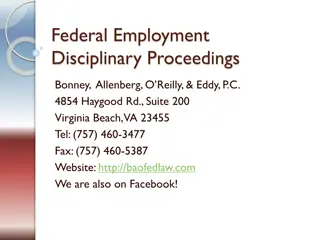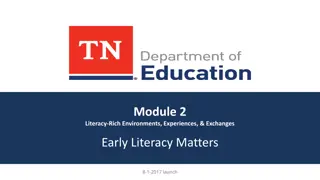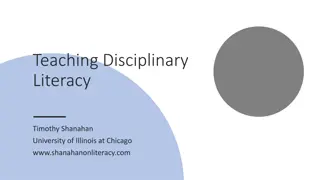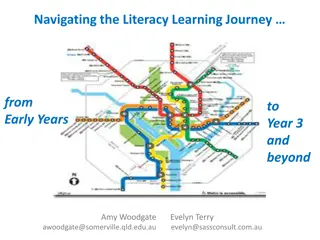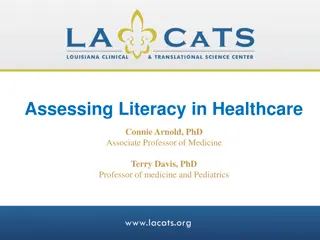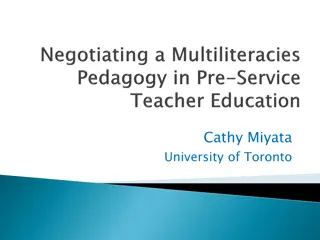Exploring Disciplinary Literacy in Education
Educators have long emphasized the importance of content area reading to improve students' comprehension and study skills across various subjects. However, disciplinary literacy goes beyond basic reading skills, focusing on how different disciplines create, communicate, and evaluate knowledge through specialized text characteristics. This approach aims to apprentice students into the unique literacy practices of specific fields of study. Today's purpose is to shed light on disciplinary literacy and offer practical recommendations to elementary teachers for supporting students in understanding diverse disciplines. Sources of disciplinary literacy include studies that compare expert readers with novices and functional linguistic analyses of specialized literacy practices. An example from history reading highlights sourcing, contextualizing, and corroboration as essential skills. Chemistry note-taking illustrates the importance of understanding atomic expressions, substances, properties, and interactions.
Download Presentation

Please find below an Image/Link to download the presentation.
The content on the website is provided AS IS for your information and personal use only. It may not be sold, licensed, or shared on other websites without obtaining consent from the author. Download presentation by click this link. If you encounter any issues during the download, it is possible that the publisher has removed the file from their server.
E N D
Presentation Transcript
CONTENT AREA READING Educators have long emphasized the idea of content area reading ( every teacher a teacher of reading ) The idea has been that we can teach basic reading skills and strategies in the content subjects Most of this emphasis in content area reading has been on secondary school classes Emphasis on developing basic reading comprehension and study skills that can be used across the subjects trying to make students better students
DISCIPLINARY LITERACY Disciplinary literacy is not the same thing Each discipline creates, communicates, and evaluates knowledge in different ways and for different purposes. These differences entail different text characteristics and different approaches to reading and writing Disciplinary literacy instruction is about apprenticing students into these fields of study (to learn the purpose and methods of a subject and the relevant literacy insights) foregrounding the differences
TODAYS PURPOSE AND PLAN I want to explain and illustrate what disciplinary literacy is so that you ll understand the basic construct and what it is that the middle school and high school teachers are trying to accomplish Then I want to make practical recommendations to elementary teachers so they can best support the apprenticing of students into the disciplines
SOURCES OF DISCIPLINARY LITERACY Studies that compare expert readers with novices (Bazerman, 1985; Geisler, 1994; Wineburg, 1991, etc.) Functional linguistics analyses of the specialized literacy/language practices used in the disciplines (Fang, 2004; Halliday, 1998; Schleppegrell, 2004, etc.)
EXAMPLE OF EXPERT-NOVICE STUDY Wineburg s study of history reading: Sourcing: considering the author and author perspective Contextualizing: placing documents within their historical period and place Corroboration: evaluating information across sources
CHEMISTRY NOTE CHEMISTRY NOTE- -TAKING TAKING Atomic Expression Substances Properties Processes Interactions
Increasing Specialization of Literacy Disciplinary Literacy Intermediate Literacy Basic Literacy
EXAMPLE FROM FUNCTIONAL LINGUISTICS Halliday s analysis of language change in science. Glass cracks more quickly the harder you press on it. Cracks in glass grow faster the more pressure is put on. Glass crack growth is faster if greater stress is applied. The rate of glass crack growth depends on the magnitude of the applied stress. Glass crack growth rate is associated with applied stress magnitude.
LITERACY IN HISTORY/SOCIAL STUDIES Cite specific textual evidence to support analysis of primary and secondary sources, attending to such features as the date and origin of the information. Analyze in detail a series of events described in a text and the causes that link the events; distinguish whether earlier events caused later ones or simply preceded them. Identify aspects of a text that reveal an author s point of view or purpose (e.g., loaded language, inclusion or avoidance of particular facts). Compare the point of view of two or more authors by comparing how they treat the same or similar historical topics, including which details they include and emphasize in their respective accounts. Interpret the meaning of words and phrases in a text, including how an author uses and refines the meaning of a key term over the course of a text (e.g., how Madison defines faction in Federalist No. 10 and No. 51). .
LITERACY IN HISTORY/SOCIAL STUDIES Evaluate authors differing points of view on the same historical event or issue by assessing the authors claims, evidence, and reasoning. Distinguish among fact, opinion, and reasoned judgment in a historical account. Compare and contrast treatments of the same topic in several primary and secondary sources. Evaluate an author s premises, claims, and evidence by corroborating or challenging them with other sources of information. Integrate information from diverse sources, both primary and secondary, into a coherent understanding of an idea or event, noting discrepancies among sources. .
LITERACY IN SCIENCE/TECHNICAL SUBJECTS Determine the meaning of symbols, key terms, and other domain-specific words and phrases as they are used in a specific scientific or technical texts and topics. Integrate quantitative or technical information expressed in words in a text with a version of that information expressed visually (e.g., in a flowchart, diagram, model, graph, or table). Distinguish among facts, reasoned judgment based on research findings, and speculation in a text. Follow precisely a complex multistep procedure when carrying out experiments, taking measurements, or performing technical tasks, attending to special cases or exceptions defined in the text.
LITERACY IN SCIENCE/TECHNICAL SUBJECTS Translate quantitative or technical information expressed in words in a text into visual form (e.g., a table or chart) and translate information expressed visually or mathematically (e.g., in an equation) into words. Compare and contrast findings presented in a text to those from other sources (including their own experiments), noting when the findings support or contradict previous explanations or accounts. Cite specific textual evidence to support analysis of science and technical texts, attending to important distinctions the author makes and to any gaps or inconsistencies in the account. Synthesize information from a range of sources (e.g., texts, experiments, simulations) into a coherent understanding of a process, phenomenon, or concept, resolving conflicting information when possible.
LITERACY IN LITERATURE Determine two or more themes or central ideas of a text and analyze their development over the course of the text, including how they interact and build on one another to produce a complex account; provide an objective summary of the text. Analyze the impact of the author s choices regarding how to develop and relate elements of a story or drama (e.g., where a story is set, how the action is ordered, how the characters are introduced and developed). Determine the meaning of words and phrases as they are used in the text, including figurative and connotative meanings; analyze the impact of specific word choices on meaning and tone, including words with multiple meanings or language that is particularly fresh, engaging, or beautiful. (Include Shakespeare as well as other authors.) Analyze how an author s choices concerning how to structure specific parts of a text (e.g., the choice of where to begin or end a story, the choice to provide a comedic or tragic resolution) contribute to its overall structure and meaning as well as its aesthetic impact.
LITERACY IN LITERATURE Analyze a case in which grasping a point of view requires distinguishing what is directly stated in a text from what is really meant (e.g., satire, sarcasm, irony, or understatement). Analyze multiple interpretations of a story, drama, or poem (e.g., recorded or live production of a play or recorded novel or poetry), evaluating how each version interprets the source text. (Include at least one play by Shakespeare and one play by an American dramatist.) Demonstrate knowledge of eighteenth-, nineteenth- and early-twentieth-century foundational works of American literature, including how two or more texts from the same period treat similar themes or topics.
1. BUILD BASIC LITERACY SKILLS Number one complaint of content teachers? Students can t read the texts It is critical that K-5 teachers ensure that children have well developed phonemic awareness, phonics skills, oral reading fluency, and basic comprehension abilities Need to provide substantial amounts of explicit instruction in these skills and abilities with lots of opportunities to practice them
BUILD BASIC SKILLS Phonemic awareness instruction ensures that children can perceive sounds within words, hold them in memory, and operate on them Phonics instruction enables children to translate letters and spelling patterns into sounds and pronunciations (translating written to oral language) Oral reading fluency instruction supports children s ability to decode accurately and with sufficient speed to make sense of text Reading comprehension instruction guides students to expect text to be meaningful and to think in ways, while reading, that support understanding and recall
2. DEVELOP EXTENSIVE CONTENT KNOWLEDGE Even before they become readers, kids can start learning about their social and natural worlds Disciplinary literacy depends heavily on disciplinary knowledge
DEVELOP EXTENSIVE CONTENT KNOWLEDGE Many schools reduce the amount of social studies, sciences, arts, etc. to try to enhance reading achievement Or, they provide such instruction but pay little attention to it because meeting the standards in those subjects doesn t count But research shows that prior knowledge plays an important role in reading comprehension Opportunities lost in reading instruction in not having kids read texts that both support learning to read and learning content Some teachers don t value the knowing of information since anyone can look that up on Google big mistake, knowledge matters
DEVELOP EXTENSIVE CONTENT KNOWLEDGE Teach content subjects in the elementary grades and protect this instructional time Adopt content learning standards for your reading texts (not just your content texts) that is specify what it is that kids are going to learn about the social or natural world from the texts that are to be read Engage students in project-based learning in their content classes
3. EXPOSE STUDENTS TO DISCIPLINARY TEXTS Students should have access to disciplinary texts in science, history, math, and literary texts Informational texts should have a wide range of text types, modalities, and purposes
EXPOSE STUDENTS TO DISCIPLINARY TEXTS Include informational texts in reading instruction itself Include informational texts in classroom libraries Don t be afraid of informational texts for read alouds Many districts don t provide texts for the various subjects (for instance, they try to only teach hands on science BIG MISTAKE Use appropriate texts in science, social studies, etc.
4. GUIDE READING OF DISCIPLINARY TEXTS Require that students read disciplinary texts and hold them accountable for making sense of these Provide guidance to teach them how to read these text independently
GUIDE READING OF DISCIPLINARY TEXTS Even when texts are available many teachers don t use these and often use them poorly A typical text-centered content lesson is done through round robin reading with the teacher elaborating on the text (a very weak introduction to disciplinary text!) Guide students to do accountable reading (and rereading)-- including the reading of graphics
5. DEVELOP DISCIPLINARY VOCABULARY Teach students the vocabulary of the subject areas Build their knowledge of morphemes relevant to those subject areas Develop their ability to make sense of vocabulary from text
DEVELOP DISCIPLINARY VOCABULARY Vocabulary is the intersection of content and language Teach students both the specialized vocabulary of the content that you teach and other key words that matter to comprehension Don t preteach all the words (for instance, most technical terms in science books are defined in the text those should not be pretaught)
DEVELOP DISCIPLINARY VOCABULARY Photosynthesis may sound like a big word, but it's actually pretty simple. You can divide it into two parts: "Photo" is the Greek word for "Light," and "synthesis," is the Greek word for "putting together," which explains what photosynthesis is. It is using light to put things together. You may have noticed that all animals and humans eat food, but plants don't eat anything. Photosynthesis is how plants eat. They use this process to make their own food. Since they don't have to move around to find food, plants stay in one place, since they can make their food anywhere as long as they have three things.
DEVELOP DISCIPLINARY VOCABULARY Photosynthesis may sound like a big word, but it's actually pretty simple. You can divide it into two parts: "Photo" is the Greek word for "Light," and "synthesis," is the Greek word for "putting together," which explains what photosynthesis is. It is using light to put things together. You may have noticed that all animals and humans eat food, but plants don't eat anything. Photosynthesis is how plants eat. They use this process to make their own food. Since they don't have to move around to find food, plants stay in one place, since they can make their food anywhere as long as they have three things.
PREFIXES ELA Math Science Soc Stuides com- X X X X con- X X X X de- X X X X dis- X X ex- X X X X in- X X X X inter- X pre- X pro- X X X re- X X X X sub- X X trans- X un- X
Derivational Suffixes ELA Math Science Soc Stuides -al X X X X -ar X X -ary X X -ate X X X X -ation X X X X -ent X X X -ic X X X X -ism X X -ist X -ity X X X X -ive X X X X -ize X X X -ment X X X X
Derivational Suffixes ELA Math Science Soc Stuides -or X X -sion X X X X -tion X X X X -ture X X
Combining Forms ELA Math Science Soc Stuides ana X arch X auto X bio X X chem X cracy, crat X dem, demo X eco X electro, elect X endo X geo X X gon X gram X
Combining Forms ELA Math Science Soc Stuides graph X X hedron X hydro X logy (ology) X X X meter, metr X X micro X nym, onym X -oid X para X X photo X poly X scope X sphere X X
Combining Forms ELA Math Science Soc Stuides sym- X syn- X X therm, thermo X tri- X
6. WORK WITH MULTIPLE TEXTS Some subjects (e.g., social studies) depend upon the reading of multiple texts Students should have the opportunity to work with multiple texts in such subjects Other subjects (e.g., science) depend upon the reading of multi- modal text Students should have the opportunity to work with those multiple texts, too
WORK WITH MULTIPLE TEXTS History knowledge is not factual, but plausible Historians develop their plausible interpretations of what happened and why based on their analysis of evidence drawn from multiple perspectives Having students synthesizing texts comparing them to determine their agreements and disagreements is valuable Historical Scene Investigation https://hsi.wm.edu/
WORK WITH MULTIPLE TEXTS Science attempts to describe phenomena and processes in the natural world Language is not sufficient for accurately summarizing scientific knowledge For this reason, scientific communication depends upon language, graphics, and mathematics Guiding students to identify the purpose of graphics, teaching them how to interpret graphics, and showing them how to compare graphics with the text all should have a place in the science class
7. TEACH DISCIPLINARY WRITING, TOO One of the most effective ways of teaching text characteristics, formatting, and the like is to have students trying to use these features productively in their writing Students should have opportunities to write papers and to produce presentations that effectively communicate information about content
TEACH DISCIPLINARY WRITING, TOO Research shows that writing about text increases student learning (Graham & Hebert, 2010) Having students write summaries of text are particularly valuable in the elementary grades There are also benefits for having students write explanation in mathematics And, for having students synthesize information across texts
8. INTRODUCE DISCIPLINARY APPROACHES To the extent that available texts allow, introduce students to the reading routines and special text characteristics of the disciplines
HISTORY EVENTS CHART HISTORY EVENTS CHART TEXT WHO? WHAT? WHERE? WHEN? WHY? 1 Relation: 2 Relation: 3 Relation 4 Main point:
CHARACTER CHANGE CHARACTER CHANGE CHART CHART What is main character like at the beginning of the story? What is the main character like at the end of the story? How has he or she changed? Crisis Given this character change, what do you think the author wanted you to learn? ________ ________________________________________________________________________ ________________________________________________________________________


